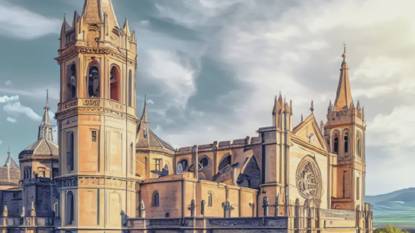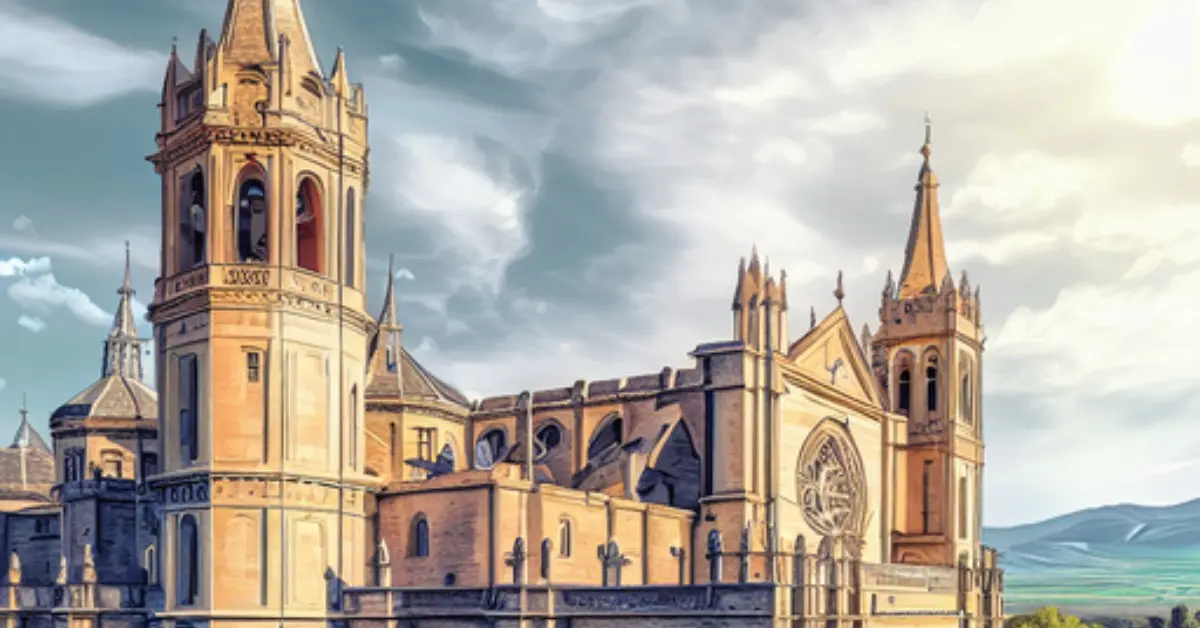
Camino Francés: Pamplona to Saint-Jean-Pied-de-Port
Posted: | Updated:Reading time: 22 minutes
Camino Francés: Pamplona to Saint-Jean-Pied-de-Port
Posted: | Updated:Reading time: 22 minutes
By: Simon Kemp, Editor
Why Start the Camino Frances Journey at Pamplona?
For many international travelers, flying into Madrid and then continuing on to Pamplona is a common route for exploring the beautiful landscapes and cultural heritage of Spain. However, for those planning to embark on the famous Camino Frances pilgrimage , traveling from Pamplona to St Jean-Pied-de-Port can be a bit more challenging.
How to Get to Pamplona from Madrid?
Madrid and Pamplona are two of the most popular tourist destinations in Spain. There are several ways to travel between these two cities, including by train, bus, and car.
Train
Traveling by train is one of the most comfortable and convenient ways to travel from Madrid to Pamplona. The journey takes around three hours and 30 minutes and costs approximately €30-€60, depending on the train company and class of travel. There are several trains that operate this route, including high-speed trains (AVE) and regional trains (Cercanias). The trains depart from Madrid’s Chamartin train station and arrive at Pamplona’s train station, which is located in the southeast of the city center.
Bus
Traveling by bus is a more affordable option for traveling from Madrid to Pamplona. The journey takes approximately four hours and costs around €20-€40, depending on the bus company and time of day. There are several bus companies that operate this route, including ALSA and La Estellesa. The buses depart from Madrid’s Mendez Alvaro bus station and arrive at Pamplona’s bus station, which is located in the city center.
Car
Renting a car is another option for traveling from Madrid to Pamplona. The journey takes around four hours and is a good option if you want to explore the surrounding areas or if you have a lot of luggage. The route is well signposted, and there are several major highways that connect Madrid to Pamplona. However, be aware that parking in Pamplona can be difficult, especially in the city center.
Overall, there are several ways to travel from Madrid to Pamplona, each with its own advantages and disadvantages. Traveling by train is the most comfortable and convenient option, while traveling by bus is the most affordable. Renting a car is a good option if you want to explore the surrounding areas or if you have a lot of luggage. Whatever mode of transportation you choose, traveling between these two destinations is relatively easy and straightforward, making it a popular route for tourists visiting Spain.
Map of Pamplona to Saint-Jean-Pied-de-Port
Can you fly from Madrid to Pamplona?
Yes, you can fly from Madrid to Pamplona, but it is not the most common mode of transportation for this route. There are direct flights from Madrid to Pamplona. Flights are operated by Iberia, and the flight time is usually around one hour. The frequency of flights varies throughout the year, with more flights available during peak travel seasons.
Pamplona Airport (PNA) is located approximately 6 kilometers from the city center, and there are several transportation options available to get to the city, including taxis and buses.
Flying from Madrid to Pamplona may be a convenient option for those who are short on time or who prefer air travel to other modes of transportation. However, it may not be the most cost-effective option compared to taking a train or bus to St Jean Pied a Port.
Traveling from Pamplona to St Jean-Pied-de-Port
Once you arrive in Pamplona, you will need to travel to St Jean-Pied-de-Port to start your Camino de Santiago pilgrimage. There are several ways to travel between these two destinations, including by bus or taxi.
Taking a bus is the most affordable option, with buses leaving from Pamplona’s bus station and arriving at St Jean-Pied-de-Port’s bus station. The journey takes approximately two hours and costs around €10-€15, depending on the bus company and time of day.
Traveling by taxi is a more expensive option but is a good choice if you are traveling with a group or have a lot of luggage. The journey takes around one hour and 30 minutes and costs approximately €120-€150. It is recommended to book a taxi in advance, as they may not be readily available at the Pamplona train station.
Overall, traveling from Madrid to Pamplona and then on to St Jean-Pied-de-Port is a popular route for tourists embarking on the Camino de Santiago pilgrimage. Whether you choose to fly, take a bus, or a train, there are several options available to make your journey as comfortable and convenient as possible. Once you arrive in Pamplona, traveling to St Jean-Pied-de-Port by bus or taxi is relatively easy and straightforward, and will get you on your way to one of the world’s most famous pilgrimages.
Camino Francés Diary: preliminary segment
Tuesday 26th September 2000
This was in fact a taxi ride to St-Jean-Pied-De-Port from Pamplona where I arrived, by plane from Madrid, the night before. I stayed in a hotel in the center of Pamplona that would prove to be luxury in comparison with the Albergues (refugios des peregrinos) or pilgrim’s hostels that I will stay in for the next three weeks.
When I left the hotel this morning I spent some time walking around looking for the bus and train stations. Both are normally found in the centers of cities, but not in Pamplona. The train station is right on the outskirts of the city.
There seems to be no way to get to St-Jean-Pied-de-Port, they have never heard of it, even when I wrote out the name. It seems that you have to get a train to Bayonne and then local trains from there and it will take all day. There are also no more buses, I missed the only one which was early in the morning. So a taxi is the only option. The surprise is that it only cost £30 for an 80 KM trip, which is incredible. Everything is so cheap here, less than half that of the UK.
The taxi driver is very friendly. He knows about the Camino and points out items of interest on the way. I am passing through all the towns and villages I will walk through on the way back. We stop for a coffee at Roncesvalles which is the starting point for the Camino in Spain itself. I was to meet many people later starting from there rather than St-Jean-Pied-de-Port.
Strange that no one has asked for a passport when crossing the border. There won’t even be an obvious border when I walk back. The taxi pulls in to St-Jean-Pied-de-Port and I pay the taxi driver. We shake hands and part as friends, which I have never done with a taxi driver before. I will find that all the Spanish people I meet, with only one notable exception, will be exceptionally nice people.
At St Jean, the full impact of what I am going to be doing hits me. I am in a foreign country where I do not speak the language and I have to find a particular address somehow. I look around for a sign and see one, which says something like “table de orientation” which I assume to mean somewhere to get your bearings. No such luck. Every direction out of St Jean is straight up!
I start walking and after two miles of climbing I begin to realize I am actually walking the road “Camino Napoleon” that I will take tomorrow, without the pilgrim’s passport, which I will need to stay in the refuges on the way. I stop at a house and ask for directions. The woman seems to know that I am a pilgrim (peregrino) and points me back the way I have just come!
In the town, I walk through to the other side and discover the office Acquielle St Jacque which is on the road up to the Citadel, half way up the hill. It is 14:00 and the office does not open again till 15:00 so I wander about town. There is not much here except for a strangely clean river.
Apart from the Highlands of Scotland, the Scottish Borders, the Lake District and most parts of Wales, rivers in the United Kingdom tend to be dirty with cloudy polluted water and a lot of discarded rubbish. I will be constantly surprised at the cleanliness of the rivers in the Pyrenees and in Spain itself. I find a souvenir shop and buy a sturdy stick. This stick will be a lifesaver for me but I will lose it much later.
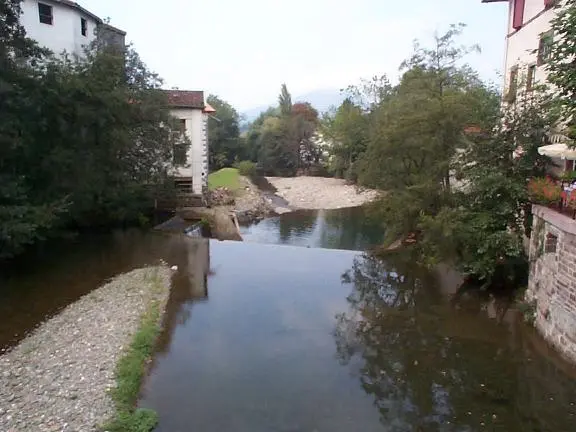
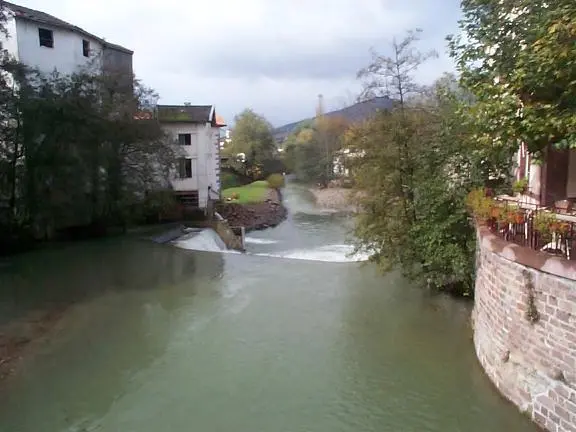
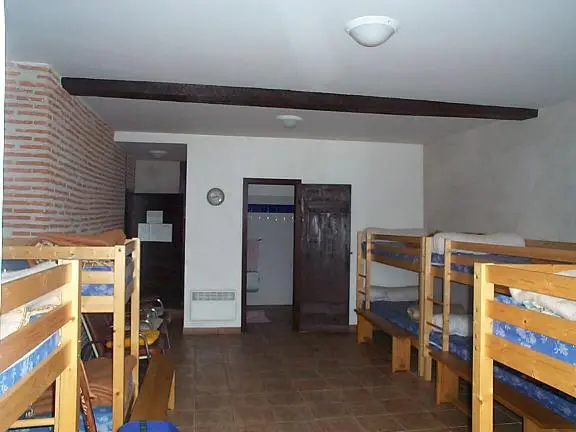
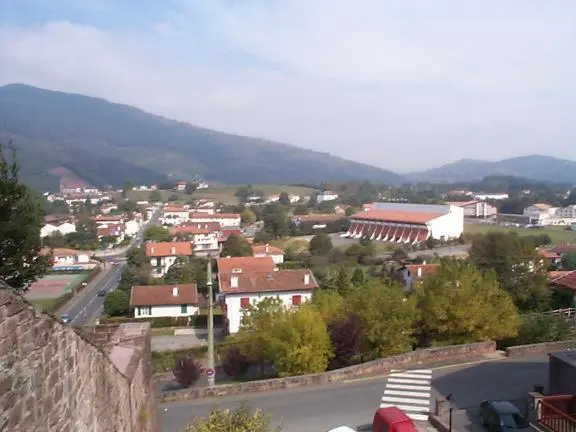
When the office is open I go in and ask for the pilgrim’s passport. I am expecting to meet a “Madame De Brill”, after reading many Camino books and web sites, but she is not there and a French chap hands me the information form. It turns out that “Madame De Brill” died the previous year.
No problems filling in the form and he asks me if I wish to stay in the refuge that night. In total it costs 1000 pesetas for the passport and 500 pesetas for the refuge. At an exchange rate of 300 pesetas to the pound that worked out at £1.75. Try staying anywhere in the UK for that!! I say yes and his sidekick takes me a few houses up the street and shows me a very basic room with several bunk beds. This will be typical of refuge accommodation and I will get used to it very quickly.
I am the only person at first but eventually two Dutchmen turn up. They have walked all the way from Holland to get here. That’s over a 1000 KM, more than I will walk on the Camino. An old French couple appear next followed by a lone Frenchman. I will only meet them all again once more in Roncesvalles. They walk too fast for me. By evening, two French girls, Margaux and Ophelia, A German chap, Ferdinand and a French Canadian, Thierry show up together.
They have all met together on the train to “St Jean Pied De Port” and I will meet all of them many times over the next three weeks. I will develop a particularly strong bond with Thierry and to a lesser degree with Ferdinand. The girls will prove to usually be the last to arrive at a refuge each day and their arrival anxiously awaited by us all. Towards the end of my walk, I will find out why they are always late.
I have never shared a room with 11 strangers before, some female, and most of them snore. The women, if they snore, are always much louder than the men! So I do not get much sleep that night, being kept awake by the old French woman. That experience will also repeat itself many times in refuges, even with earplugs.
Typically the beds are simple metal frameworks, although here they are wooden, and when the person on the top bunk moves, the whole bed shakes, which wakes me up.
So every night from now on I will only get short bouts of deep sleep punctuated with being woken up. It will be two weeks before I get a good night’s sleep, in the hotel where I am writing this account.
The view from the window of the refuge is impressive. It seems that all the houses in this part of the country and the other side of the Pyrenees are built with white walls and red roofs. They look good.
That evening there is the best thunderstorm I have ever heard. Thunder in the mountains has a completely different sound to it than what you get in a city and I have not heard this sort before. It is very visceral and hits you with the sort of bass punch you get from an air show display or a really good HiFi.
How Do You Get from Pamplona to St Jean-Pied-de-Port?
This is a popular route for tourists who are planning to embark on the famous Camino de Santiago pilgrimage. If you land at Pamplona Airport following an International flight into Madrid, then as well as being very tired, you will want to figure out how to get to the starting point of your Camino Frances journey. There are several ways to travel between these two destinations, including by bus, train, taxi, and car.
Bus
The most affordable way to travel this route is by bus. The journey takes approximately two hours and costs around €5-€10, depending on the bus company and time of day. There are several bus companies that operate this route, including La Estellesa and Conda.
Train
Another option for traveling this segment is by train. However, there is no direct train service between these two destinations, and you would need to take a train to the nearby city of Bayonne and then transfer to a bus or taxi to reach Saint-Jean-Pied-de-Port. The journey takes around three hours and costs approximately €25-€30.
Taxi
Traveling by taxi is a more expensive option but is a good choice if you are traveling with a group or have a lot of luggage. The journey takes around one hour and 30 minutes and costs approximately €120-€150. It is recommended to book a taxi in advance, as they may not be readily available at the Pamplona train station.
Car
If you prefer to drive, renting a car is an option. The journey takes approximately one hour and 30 minutes, and the route is well signposted. However, parking in Saint-Jean-Pied-de-Port can be difficult, and it is recommended to park outside the town and walk in.
Overall, there are several ways to travel from Pamplona to Saint-Jean-Pied-de-Port, each with its own advantages and disadvantages. The most affordable option is by bus, while the most convenient option may be to rent a car. Whatever mode of transportation you choose, traveling between these two destinations is relatively easy and straightforward, making it a popular route for tourists embarking on the Camino de Santiago pilgrimage.
Where is Pamplona Bus Station?
The main bus station in Pamplona is called Estación de Autobuses de Pamplona (Pamplona Bus Station). It is located on Calle Yanguas y Miranda, s/n, 31002 Pamplona, Navarra, Spain. The station is conveniently located in the city center, just a short walk from the historic old town and major tourist attractions. From here, you can catch buses to various destinations in Spain and other European countries. The station is well-equipped with amenities such as restrooms, cafes, and shops.
Where is Pamplona Train Station?
The main train station in Pamplona is called Estación de Pamplona (Pamplona Train Station). It is located on Plaza de la Estación, s/n, 31012 Pamplona, Navarra, Spain. The station is situated on the southeast side of the city center, near the university and the Yamaguchi Park. From here, you can catch trains to other cities in Spain, including Madrid, Barcelona, and Bilbao. The station is well-equipped with amenities such as restrooms, cafes, and shops.
How to take a Taxi in Pamplona?
Taking a taxi in Pamplona is a convenient way to get around the city, especially if you are carrying heavy luggage or traveling in a group. Here are the steps to take a taxi in Pamplona:
- Look for a taxi stand: There are several taxi stands located throughout the city, including at the train station, the bus station, and in the city center. You can also hail a taxi on the street if you see one passing by.
- Check the taxi availability: Look for a taxi that is available to pick you up. If the taxi light is off, it means it is already occupied.
- Give your destination: Once you get inside the taxi, tell the driver your destination. If you don’t speak Spanish, it’s a good idea to have your destination written down or saved on your phone.
- Confirm the fare: Make sure to confirm the fare with the driver before starting the journey. Taxis in Pamplona are required to have a meter that calculates the fare based on distance and time, but it’s always a good idea to confirm the fare beforehand to avoid any surprises.
- Pay the fare: Once you arrive at your destination, pay the fare to the driver. Most taxis in Pamplona accept cash, but some may also accept credit cards.
Overall, taking a taxi in Pamplona is a straightforward and convenient way to get around the city. Just make sure to confirm the fare beforehand and carry cash in case the taxi doesn’t accept credit cards.
Departure point: Pamplona
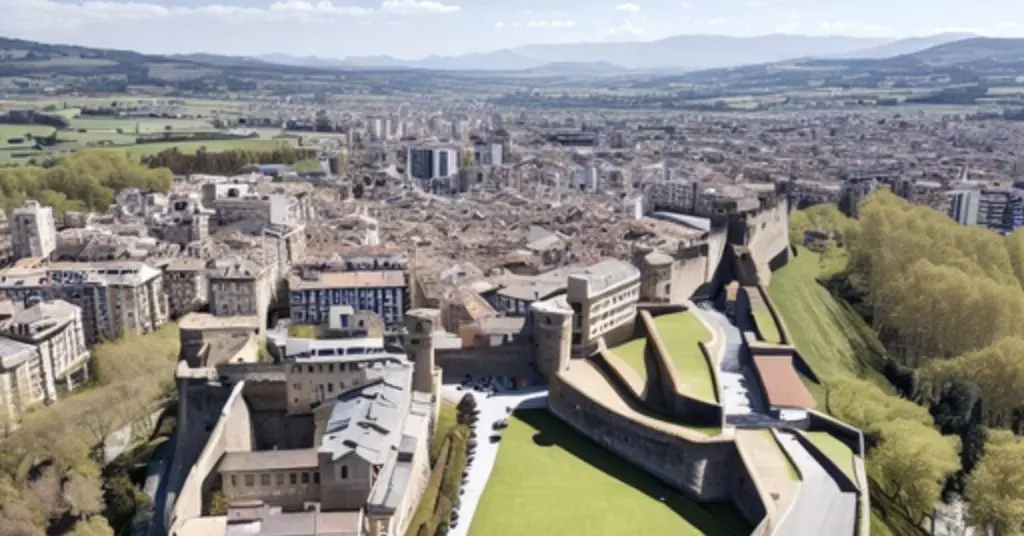
Exploring the History and Culture of Pamplona, Spain
Pamplona is a city that is rich in history and culture, located in the northern part of Spain. This city is the capital of the Navarre region and has a significant importance in the country. In this article, we will explore the history, geography, economy, culture, and notable attractions of Pamplona.
Pamplona is a city that offers a rich and diverse cultural experience, from its fascinating history to its stunning landscapes and famous festivals. Whether you are interested in exploring the city’s museums and art galleries, indulging in its culinary delights, or taking part in the thrilling Running of the Bulls, Pamplona has something for everyone.
History of Pamplona
Pamplona has a long and fascinating history that dates back to the Roman times. It was founded by the Romans in the 1st century BC, and was originally called Pompaelo. The city was located on a strategic trade route that connected the Pyrenees with the rest of the Iberian Peninsula.
During the early Middle Ages, Pamplona was an important center of Basque culture and language. In the 9th century, it became the capital of the Kingdom of Navarre, which was an independent state until the late 15th century.
In the late 16th century, Pamplona became a fortress city to protect the region from invasion. It was also an important commercial center during this time, with trade routes that connected it to other major cities in Spain and Europe.
Geography and Climate of Pamplona
Pamplona is located in the north of Spain, in the Pyrenees Mountains. It has a varied topography, with hills, valleys, and plateaus. The city is surrounded by mountains, which provide a stunning backdrop to its skyline.
The climate in Pamplona is continental, with cold winters and warm summers. The average temperature in the summer months (June to August) is around 25°C (77°F), while in the winter months (December to February) it can drop to around 5°C (41°F). The city is also known for its strong winds, particularly in the winter.
Urbanism and Economy of Pamplona
Pamplona has a well-planned layout that dates back to the 18th century. It is organized around a central axis, the Avenida de Carlos III, which runs from the Citadel to the Plaza del Castillo. The city has grown over time and now includes a variety of neighborhoods, each with its own unique character.
The economy of Pamplona is diverse, with a strong focus on industry, commerce, and services. It has a thriving business climate and is home to many international companies. The city also has a well-developed infrastructure, including excellent transportation links, modern healthcare facilities, and quality educational institutions.
Education, Culture, and Politics of Pamplona
Pamplona is known for its excellent education system and institutions. The University of Navarre, located in the city, is one of the top universities in Spain and attracts students from around the world. The city is also home to several prestigious schools and research centers.
The cultural heritage of Pamplona is evident in its numerous festivals, museums, and art galleries. The San Fermín festival, which takes place every July, is one of the most famous events in Spain and attracts thousands of visitors from around the world. The city also has several museums, including the Museum of Navarra and the Pamplona City Museum.
Politically, Pamplona is governed by a city council that is democratically elected every four years. The council is responsible for the administration of the city and the provision of public services.
Transportation and Main Sights in Pamplona
Pamplona has a well-developed transportation network that includes buses, taxis, and a light rail system. The city is also easily accessible by car, with several major highways connecting it to other cities in Spain.
The main sights in Pamplona include the Citadel, the Cathedral of Santa María, the Plaza del Castillo, and the city walls. The Citadel is a massive fortress built in the 16th century that now serves as a cultural center and park. The Cathedral of Santa María is a Gothic-Renaissance style cathedral that houses the tomb of Carlos III, the famous king of Navarre. The Plaza del Castillo is the city’s main square, surrounded by restaurants, bars, and cafes, and is a popular meeting point for locals and tourists alike. The city walls are an impressive example of medieval fortification and offer stunning views of the city and the surrounding mountains.
Other popular tourist attractions in Pamplona include the Museum of Navarra, which showcases the region’s history and art, and the Pamplona Planetarium, which offers a fascinating journey through space and time. Visitors can also take a stroll through the city’s many parks and gardens, such as the Taconera Gardens or the Yamaguchi Park, which is inspired by Japanese landscapes.
Sports, Parks, and Notable Citizens in Pamplona
Pamplona has a rich sporting culture, with a strong tradition of football, basketball, and handball. The city’s football team, Club Atlético Osasuna, is a local favorite and has a passionate following. The city also has several parks and outdoor recreational areas, such as the Arga River Park and the Yamaguchi Park, which offer opportunities for hiking, cycling, and picnicking.
Pamplona has also produced many notable citizens over the years, including the famous writer Ernest Hemingway, who was a frequent visitor to the city and wrote extensively about the San Fermín festival in his novel “The Sun Also Rises.” Other notable citizens include the physicist and Nobel Prize winner Julio Palacios and the filmmaker Carlos Saura.
Pamplona FAQs:
1. What are the top things to do in Pamplona?
Pamplona offers a variety of things to see and do, including:
- Visit the historic old town, which is home to many landmarks such as the Cathedral of Santa María, the Plaza del Castillo, and the city walls.
- Explore the Citadel, a massive fortress built in the 16th century that now serves as a cultural center and park.
- Learn about the city’s history and culture at the Museum of Navarra and the Pamplona City Museum.
- Enjoy the local cuisine, including pintxos (tapas), chistorra (a type of sausage), and Navarran wine.
- Take part in the San Fermín festival, which is a week-long celebration that includes the famous Running of the Bulls, as well as music, dance, and other events.
2. What is the significance of the San Fermín festival?
The San Fermín festival is held in honor of Saint Fermin, the patron saint of Pamplona. It is famous for the Running of the Bulls, which involves hundreds of people running ahead of a group of bulls through the narrow streets of the old town. The festival also includes religious processions, music, dancing, and other cultural events.
3. How do I get to Pamplona from nearby cities?
Pamplona has a small airport, but it is also easily accessible by train or bus from other cities in Spain, such as Madrid, Barcelona, and Bilbao. The journey times vary depending on the mode of transportation and the distance, but typically take a few hours.
4. What is the climate like in Pamplona throughout the year?
Pamplona has a continental climate with cold winters and warm summers. The average temperature in the summer months (June to August) is around 25°C (77°F), while in the winter months (December to February) it can drop to around 5°C (41°F). It is also known for its strong winds, particularly in the winter.
5. What is the history behind Pamplona’s famous running of the bulls?
The Running of the Bulls has been a tradition in Pamplona since the 16th century. Originally, it was a way to transport the bulls from the outskirts of the city to the bullring, where they would be used for bullfighting. Over time, the tradition evolved into a competition in which brave (or foolhardy) individuals would run alongside the bulls through the streets. Today, the Running of the Bulls is the most famous event of the San Fermín festival and attracts thousands of visitors from around the world.
Destination: Saint-Jean-Pied-de-Port
This is a small town in southwestern France that serves as the starting point for the Camino Francés pilgrimage to Santiago de Compostela . The town has a rich history and offers a range of services and attractions for visitors.
A charming and historically rich town that serves as an important starting point for the Camino Francés pilgrimage. Its location at the foot of the Pyrenees, range of attractions, and variety of services make it a popular destination for visitors. Whether you are a pilgrim embarking on the Camino or a tourist exploring the region, Saint-Jean-Pied-de-Port is a town worth visiting.
Location and History
Saint-Jean-Pied-de-Port is located in the Pyrénées-Atlantiques department, close to the border with Spain. It sits at the foot of the Pyrenees mountains and is surrounded by beautiful landscapes, making it a popular destination for hikers and outdoor enthusiasts. The town has been an important stop on the pilgrimage route to Santiago de Compostela since the Middle Ages, and its location at the foot of the Pyrenees has made it a strategic location in various military campaigns and conflicts, including the Hundred Years’ War and the Peninsular War.
Points of Interest
The town offers a range of attractions for visitors. One of the most notable is the Porte St-Jacques, a UNESCO World Heritage site and the traditional starting point for the Camino Francés pilgrimage. The Porte St-Jacques is a beautiful and ornate gate that was built in the 12th century and has served as the entrance to the town for centuries. Visitors can also explore the citadel, a fortified castle that was built in the 17th century to protect the town from attacks. The Church of Notre-Dame du Bout du Pont is another notable attraction, a beautiful Gothic church that dates back to the 13th century. Visitors can also walk across the 14th-century Gothic bridge over the Nive River, which offers stunning views of the surrounding landscapes. The town’s historic center is also worth exploring, with its narrow streets, half-timbered houses, and traditional Basque architecture.
Camino-related Services
As the starting point for the Camino Francés, Saint-Jean-Pied-de-Port offers a range of services for pilgrims. Accommodation options include hostels and hotels, with many specifically catering to pilgrims. Visitors can also find restaurants and cafes serving traditional Basque cuisine, including dishes like axoa, a hearty beef stew, and piperade, a vegetable and egg dish. Medical facilities, pharmacies, and other essential services are also available for pilgrims, making it a convenient and practical starting point for the Camino Francés pilgrimage.
